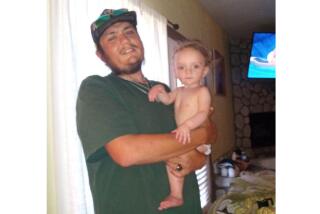HOME DESIGN : A SPECIAL ISSUE OF ORANGE COUNTY LIFE : Keeping a Child Safe Is 24-Hour-a-Day Job
- Share via
Like most 2-year-olds, Kevin Osborne enjoys playing in the kitchen cupboards. But when the game of dropping heavy soup cans left bruises on his toes, Laura Osborne put a stop to her son’s dangerous pastime. All the cabinets in their new El Toro home now have safety latches to protect Kevin and 5-month-old Kristina from injury.
Kevin has forgotten his bruised toes, but many children don’t get off so easily. The U.S. Public Health Service estimates that 19 million children under age 15 were involved last year in home accidents that resulted in injuries serious enough to require treatment.
Earlier this year, former Surgeon General C. Everett Koop told a U.S. Senate committee, “The greatest potential threat to the average American child is that child’s own family and home environment.”
The Orange County Health Care Agency’s recently formed Injury Coalition has begun to study the problem here, but figures aren’t yet available on the total number of children’s injuries that happen at home, according to Hildy Meyers, a county epidemiologist who is doing research for the Injury Coalition. What is apparent, child safety experts say, is that there are too many injuries that could be prevented.
Safety experts say injuries to children in the home result primarily from fire-related accidents, drownings, poisoning and falls. But the variety of ways in which young children can be hurt at home is limited only by their own inventiveness.
The best way to make sure your home is safe for tiny explorers is to look at it from a toddler’s point of view.
“If you really want to know what can be seen and grabbed, get on your hands and knees and crawl around the floor,” says Davine Abbott, program director of the Orange County Trauma Society.
The peanut hidden in deep pile carpet, the dangling lamp cord, the nail polish remover left on the coffee table are all potential dangers when you are 3 feet tall.
Cords should be shortened or concealed, electrical outlets covered with safety plugs and doorknobs covered with protective sleeves that tiny hands can’t manipulate.
Windows that children can climb up to should have guards, and stairs should be gated at top and bottom. Cabinets should have safety latches to keep dangerous objects out of children’s reach. Hardware stores offer a choice of cabinet locks that slide through or around handles or pressure-release or spring-type latches that require adult skills to open. None are foolproof, however.
“The best ones are whatever your child can’t get through,” says Abbott, noting that a determined toddler can outmaneuver parents’ safety efforts. She cautions that you may have to try more than one device to find one that is effective with your child.
But child-proofing isn’t permanent, so you have to take the toddler-level tour more than once, Abbott says.
“Infants’ and toddlers’ growth is so rapid, you should constantly reassess your home,” she urges.
To keep up with a child’s growing size and skill, a thorough home-safety inspection should be done every six months, she says.
No household safety measures can substitute for constant supervision, however.
“Don’t leave a child alone even for 15 minutes; take him with you to answer the phone,” Abbott says.
She cites the cost of momentary distractions. “There’s a child poisoned in this country almost every 30 seconds. And in Orange County, drownings are the No. 1 cause of injury and death for children under 4, surpassing even traffic accidents. The majority of children drowned were last seen inside the house.”
Most drownings of young children occur in back-yard pools and spas, she says, but they also happen in diaper pails, ice chests, bathtubs, showers and toilets. Lock container lids, keep bathroom doors closed and use protective sleeves on doorknobs, Abbott advises.
Pools and spas should be enclosed in layers of barriers, including pool covers, fences and self-closing, self-latching gates, she says. Don’t leave toys in or around the pool, learn cardiopulmonary resuscitation and keep a phone near the pool.
“Almost no precaution you can take is too much to prevent drowning,” emphasizes Dr. Barry Behrstock, a Newport Beach pediatrician and author of “The Parents’ When-Not-To-Worry Book.”
Still, he notes, the most common accidents among young children are not drownings but falls. “They usually scare the parents but rarely cause significant injury,” he said. Take precautions against serious injury by selecting nursery equipment carefully. Choose highchairs that are sturdy and broad-based (low feeding tables are even better). Make sure crib bars are closely spaced and mattresses fit tightly. Avoid cribs with decorative posts or cutouts--babies’ clothing could catch on them, causing strangulation. For the same reason, don’t attach cords to pacifiers or teething rings, Behrstock said.
It also helps to have a playpen or safe area where the child can be confined.
Toddlers will eat just about anything, so make sure medicines are locked up and household products are well out of reach.
Dave Harden, public education director of the UCI Regional Poison Center, says that more than 12,000 children under 6 were exposed to poisons last year in the center’s area, which includes Orange, Riverside, San Bernardino and Inyo counties. And the most common poisoning agent was baby aspirin.
Those hard-to-open caps on medicine and some household product containers aren’t child-proof at all, but more accurately child-resistant, Harden points out.
“All they do is buy you time,” he says. But that time can make all the difference.
“The highest incidence of poisoning is among 1- and 2-year-olds. They can’t read, and their color, size and shape judgment is not fine-tuned,” Harden notes.
In addition to keeping medicines locked up and household products up high, it is important to store cleaning products separately from food products, dispose of medicines by flushing them down the toilet and religiously re-cap cleaning products.
“When a mother is interrupted in doing laundry, it takes only seconds for a toddler to pull an open bottle of bleach off the washer and splash it in his eyes. Always take time to cap containers properly,” Harden advises.
Children also are at risk from poisonous plants. Some house plants, like philodendron, are toxic, so keep them out of reach. And teach children never to put leaves, berries or nuts in their mouths.
It is never too soon to start teaching fire safety, either, says Capt. Hank Raymond of the Orange County Fire Department.
Among the most common causes of burn injuries to children are scalding liquids, fires started by overloaded circuits and playing with matches, Raymond says. In addition to starting fire-safety lessons early, he recommends installing smoke detectors (check monthly to make sure they are working), indoor sprinkler systems (the typical $2,000 tab isn’t too high a price for saving lives and property, he claims) and fire extinguishers. Turn the water heater’s thermostat down to 125--hot enough for dishwashers but not hot enough to produce instant scalds. Also check out new scald-proof faucets, and consider protective faucet covers to keep little hands from turning on the hot-water tap in the bath.
Kevin Osborne’s mother recommends a foam cover that comes in animal shapes. It not only prevents children from turning faucet handles, but protects against injury from the faucet’s sharp edges, she said.
“Kevin is very venturesome. He’s a climber,” Laura Osborne says. To help protect him, she’s counting on gates at the top and bottom of the stairs, safety latches on cabinets, barriers to the back-yard spa and lessons in water safety. But all her household safety precautions are no substitute for constant supervision, Osborne acknowledges. “I’d never leave him alone,” she says.
More to Read
Sign up for Essential California
The most important California stories and recommendations in your inbox every morning.
You may occasionally receive promotional content from the Los Angeles Times.










